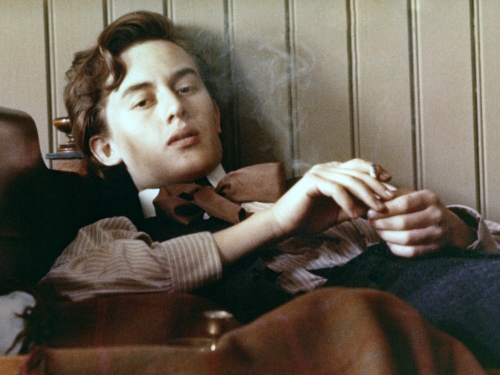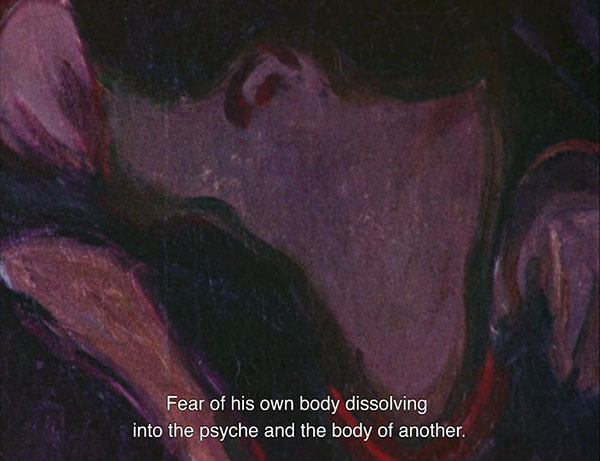
Late 19th century in Norway. Edvard Munch is a promising young painter but he is also a man tormented by his love dramas, the fear of falling ill and tapped by an idea: to be recognized at the height of his talent. Wounded by critics, rejected by the bourgeoisie to which he wants to belong, he ends up finding refuge with the anarchists.
“Edvard Munch is the most personal film I have ever made. Its genesis lies in a visit to the Edvard Munch Museum in Oslo, in 1968, during the time of a screening of several of my films by the Oslo University. I was awestruck by the strength of Munch’s canvases, especially those depicting the sad life of his family, and was very moved by the artist’s directness - with the people in his canvases looking straight at us. I also felt a personal affinity with his linking of past and present, e.g., in the large painting showing the anguish of his family as his sister Sophie is dying: the artist and his brothers and sisters are depicted as adults - as they were in the 1890s when he painted this scene - even though the event had taken place ca. 20 years earlier. On another occasion, I was also very moved by Munch’s masterpiece ‘Death of a Child’, hanging in the National Gallery in Oslo; in this painting the artist is broken, and has, in an almost desperate frenzy, blurred the form of his earlier depiction of Sophie’s death. This painting, in its time, was attacked as being “incomplete” - a charge which branded certain of his other works as well.”
Peter Watkins1
“The director is also unusually detailed on the texture and technique: you hear the brush scratching, and see exactly why he’s opting for knife, brush and oil, lithographs, woodcuts or etchings for the work at hand and his changes to canvases are detailed. Like Van Gogh, a near contemporary, Munch met with fierce resistance from the art establishment. Many reviews are heard, including phrases like “nonsense and ugliness” and “it must have been painted by someone almost mentally deranged” (a comment Munch reproduced in the red background to The Scream).”
Rob Mackie2
“The effort needed in order to see the edges of objects as they really look stirred a dim fear, a fear of what might happen if one let go one’s mental hold on the outline which kept everything separate and in its place.
When trying to think about what might be the reason for this need to make objects keep themselves to themselves within a rigid boundary I remembered reading: “The outline is … the first and plainest statement of a tangible reality.” (Gordon: A Step Ladder to Painting, p. 19).
Thus the outline represented the world of fact, of separate touchable solid objects.”
Cristina Álvarez López3


“With Edvard Munch, Peter had the journals to know what Munch said, but the director allowed a number of his amateur actors to improvise responses to Munch and when they addressed the camera. There was a loose script to the film, which overlapped sounds and images, and even had quotations from the diaries, but when I was watching him edit, only on very rare occasions did he even bother to look at it. Also, in one instance, Peter did not take kindly to some of my questions about why he was doing something in a specific way and responded with the following: “The way I work is like the film itself. I’m fusing together all the different levels all the time… Much of this is not conscious, which is why I’m not going to disturb and formalise the process by which I created that, which was very often an entirely subjective experience. I refuse to put that into rule books. I refuse to lay it out so anyone else can analyse it.” (...)
By the time he is making Edvard Munch, his methods of making films have become immensely complicated, and the risks that he is taking are greater than anything he has ever done before. Although it focuses on just ten years of the artist’s life, the film has political, social, artistic, sexual and historical contexts that flow together, like the many layers of paint on some of Munch’s paintings.”
Joseph Gomez4
- 1Peter Watkins on Edvard Munch, pwatkins.mnsi.net.
- 2Rob Mackie, “Edvard Munch”, The Guardian, november 2007.
- 3Cristina Álvarez López, “The Outline: MILNER/WATKINS/MUNCH”, Laugh Motel, september 2019.
- 4 Robert Greene in conversation with Joseph Gomez, “Portrait(s) of the exiled artist”, BFI, september 2016.

